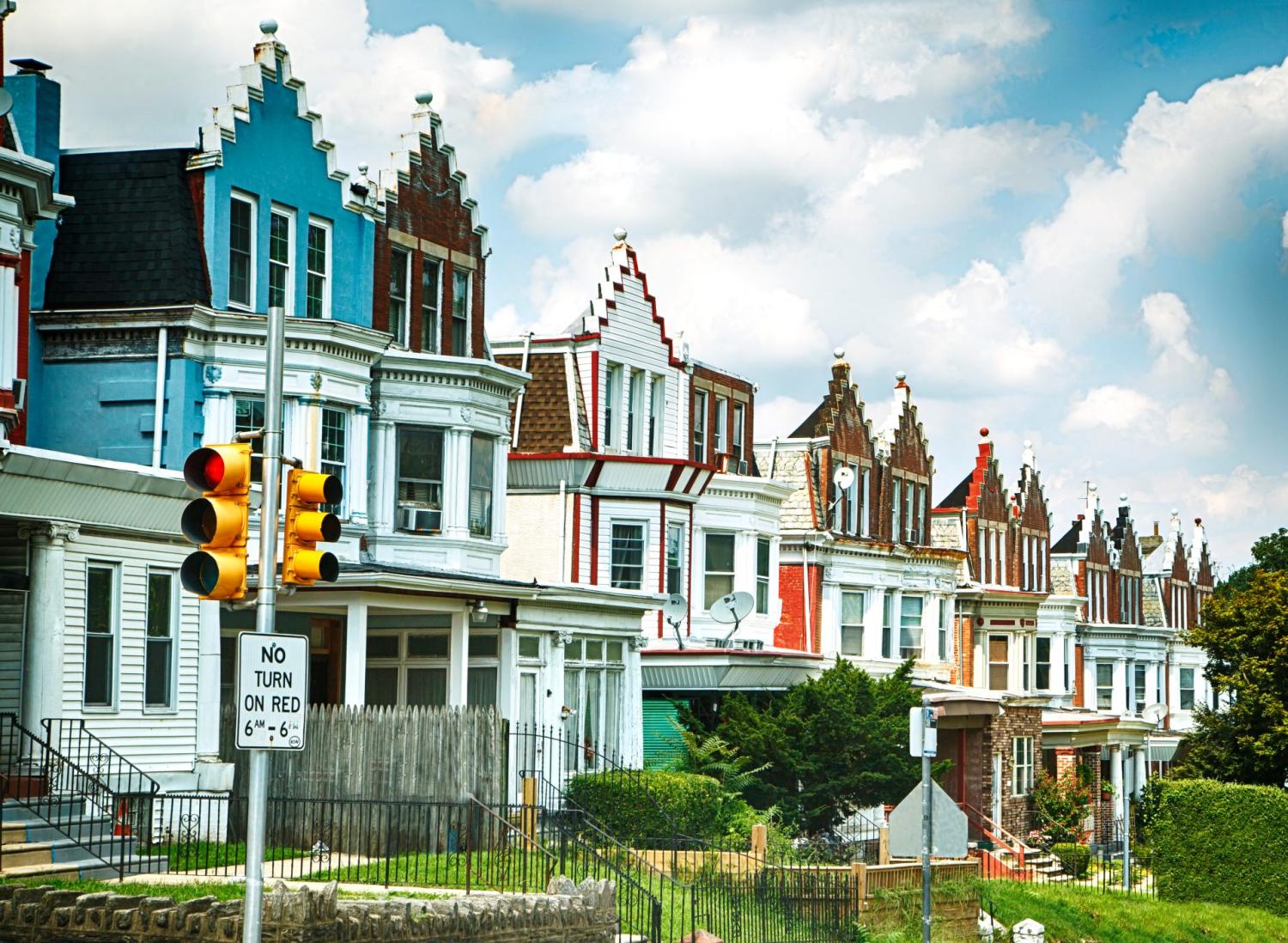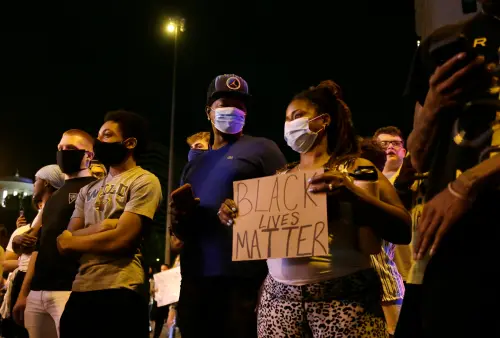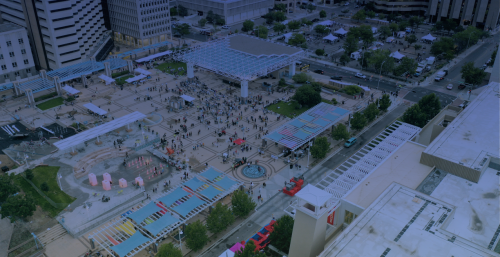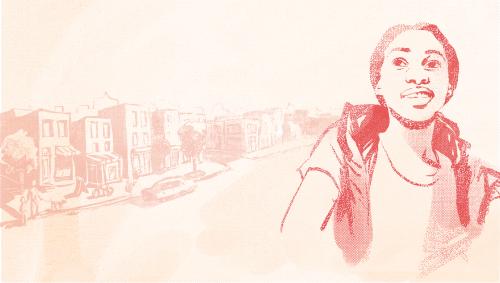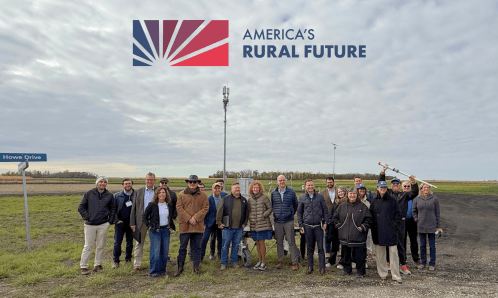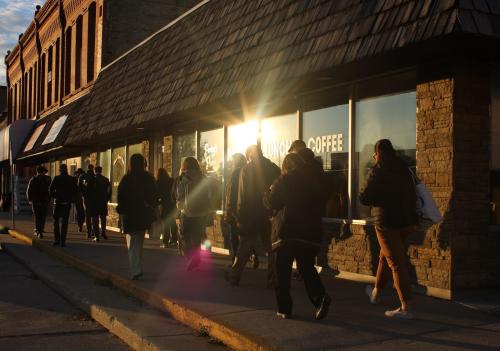The recent rise in violent crime in the United States has added another compounding layer of hardship to a nation struggling to rebuild from the events of 2020. While overall crime rates went down between 2019 and 2020, the number of murders increased by nearly 30%, largely driven by increases in firearm homicides.1
As with any headline-grabbing trend, these reports unleashed a flurry of theories—largely unsubstantiated—for what is driving the increase, with many blaming summer protests and “low morale” among police (recycled versions of the repeatedly debunked “Ferguson effect” theory).2 Others blame rising crime on the “defund the police” movement (despite the fact that most police budgets increased in the last year) or on progressive prosecution practices in cities such as Baltimore, San Francisco, and Philadelphia (theories that have also been debunked). The most obvious, and intuitive, strain of these theories acknowledges that the nation was in the middle of a pandemic that saw high unemployment, economic distress, and increased social isolation converge to increase violence.
But in taking a step back from the conjecture, it is important to note that murder rates in 2020 were nowhere near the highest they’ve ever been and that increases were mostly concentrated in disinvested and structurally disadvantaged neighborhoods that had high rates of gun violence to begin with. Additionally, an extensive body of evidence has already established the risk factors that lead to violence—as well as the solutions that are most promising to alleviate it. Despite what headlines might suggest, these risk factors have nothing to do with protests, and the solutions do not have to depend on increasing punishment.
To understand the causes of—and potential solutions to—violence in the U.S., one must pay attention to the long-standing relationship between violence and place. Within cities, gun violence is concentrated in a small set of disinvested neighborhoods, and within these neighborhoods, such violence is even more concentrated within a small set of “micro-geographic places,” like particular streets.3 This is a well-established trend that holds in every city or non-urban setting in which it has been studied.4 And when it comes to solutions, a growing body of evidence also demonstrates the promise of micro-level place-based interventions (such as rehabilitating vacant lots or increasing the number of community organizations) in significantly decreasing violence within these neighborhoods.5
In recent months, policymakers have given growing attention to the intersection between violence and place, with the Biden-Harris administration’s comprehensive plan to address gun violence setting aside funding for evidence-based community violence interventions (such as violence interrupters) and other community-based programs such as increasing summer employment opportunities, counseling availability, and wraparound services for youth living in disinvested areas. But, as Dr. Eugenia C. South recently pointed out, what’s missing from that plan is a mechanism to encourage “focused investment in the high-risk places that allow violence to thrive.” In other words, there are community interventions to treat the symptoms of violence, but not to transform the neighborhood conditions that create it.
This brief interrogates the relationship between place, violence, and policy, and takes a holistic approach in examining both the place-based factors that influence violence as well as the promising non-carceral place-based approaches to address it (i.e., approaches that require actors outside of the criminal legal system to implement). By investigating this relationship along four key dimensions of community well-being—including a place’s economic health, built environment conditions, social environment, and civic infrastructure—this brief shines light on the role that sectors outside of the criminal legal system (including the fields of community development, economic development, placemaking, and workforce development, among others) can play in supporting communities to not only reduce violence, but to thrive.
On “violence” and “crime”: Most of the research and evidence in this paper operationalizes “violence” using reported rates of violent crime. However, many forms of violence are not considered “crimes” and many “crimes” themselves are social constructs shaped by the norms and interests of a given society. As Alec Karakatsanis recently wrote in the Yale Law Journal, “a society makes choices about what acts or omissions to render worthy of different kinds of punishment”—meaning some crimes, like marijuana usage, lose their criminality over time, whereas other crimes, like crack cocaine distribution, carry disproportionate levels of punishment due to their association with a certain race or class.
The relationship between place, policy violence, and violent crime
Decades of research have established that violence is spatially concentrated within America, disproportionately occurring within a select set of high-poverty disinvested neighborhoods—and within these neighborhoods, a select set of streets.6 These are also places where the proportion of people of color is highest and indicators of structural disadvantage (such as poverty, lower educational attainment, and high unemployment) cluster.7
These neighborhood conditions directly stem from what my colleagues Andre Perry and Tawanna Black, among others, have called “policy violence.” For instance, a robust body of evidence demonstrates the connection between state-sponsored racial segregation and rates of violence. An analysis of historically redlined areas found that even after adjusting for the socio-demographic factors, “the same places that were imagined to be areas unworthy of economic investment by virtue of the races, ethnicities, and religions of their residents are more likely to be the places where violence and violent injury are most common almost a century later.”8 A study of 103 major metropolitan areas found that from 1970 to 2010, racial segregation substantially increased the risk of homicide victimization for Black people.9 Numerous studies have found that concentrated poverty, densely crowded housing, and a high density of alcohol outlets, mortgage foreclosures, and vacant buildings and lots are directly associated with higher rates of violence.10 This in turn causes a range of other negative community impacts: People living in high-crime neighborhoods have higher death rates from stress-responsive diseases, are more likely to withdraw from neighborhood social and civic life, and are more likely to have pre-term births, which have lasting implications for children’s development across the community.11
Yet, rather than address these place-based drivers of violence with investments to mitigate them, the criminal legal system status quo has often been to police markers of place-based poverty even further—to disastrously harmful effects. The 1980s-era “broken windows” theory is the most notorious of these examples, which led to overpolicing low-level offenses in communities of color and was ineffective at reducing violent crime; in fact, some cities and counties have found that by stopping prosecution of these kinds of low-level nonviolent crimes, violent crime rates actually went down.12 A similarly misguided approach was adopted in New York City with the unconstitutional practice of “stop and frisk,” which led to young men and women reporting increased rates of anxiety and depression, withdrawing from civic life, dropping out of school, and experiencing lasting distrust of police systems.13
Different manifestations of place-based policing have taken root nationwide—including strategies such as hot spots policing, predictive policing, “place-based investigation units,” “ShotSpotter” gun detection technology, and enforcement-based foot patrol in high-crime neighborhoods—many of which have been found to be less effective than non-carceral alternatives in reducing violence and have led to untold harm in communities of color, including the killing of Breonna Taylor in Louisville, Ky.
The approach that many policymakers seem to be missing is that to address spatially concentrated violence, we must actually support and invest in those communities most at risk to it. This task inherently requires those outside of the criminal legal system to take on violence mitigation as an integral component of their work.
A holistic look at place-based drivers of—and solutions to—violence
A look at four key dimensions of community well-being can inform our understanding of how place-based factors influence violent crime and, in turn, how a holistic approach to addressing these factors can provide promising non-carceral alternatives for community safety.
1. The built environment (or physical conditions) of a neighborhood is strongly associated with rates of violence.
The most consistent evidence on the relationship between violence and place exists in the realm of housing and vacancies, with numerous studies finding that the renovation of housing, vacant buildings, land, and lots in disinvested communities significantly reduces violent crime rates.14 For instance, in Philadelphia, researchers found that structural repairs to homes of low-income owners in majority-Black neighborhoods were associated with a 21.9% reduction in total crime.15 Another study in Philadelphia found that efforts to transform and clean vacant lots in high-poverty neighborhoods led to a 29% reduction in violent crime.16
Evidence also finds that other improvements to the public realm—such as urban greening and tree canopy programs in urban neighborhoods—reduce violent crime, particularly adolescent gun violence.17 In one Philadelphia neighborhood, a population-based case-controlled study conducted between 2008 and 2014 found that the presence of street lighting, painted sidewalks, public transportation, and parks was associated with at least 76% decreased odds of a homicide.18
These findings point to the need for urban planning, design, and placemaking practitioners to understand the intersections between gun violence and the physical attributes of a community—and to invest in safe streets, parks, and vacant lot remediation not only as a tool to create great places, but to support safe and thriving communities. Some communities, such as Brownsville, Brooklyn, have already begun to integrate holistic understandings of safety within their placemaking practices—engaging young people to map their levels of safety in different places within their neighborhood and launch creative placemaking projects to promote an overall safer neighborhood. The city of Milwaukee engaged in a placemaking process to promote public safety and social cohesion through extending a neighborhood trail to connect residents of Harambee (a predominantly Black and low-income neighborhood) and Riverwest (one of the Milwaukee’s most racially and economically diverse neighborhoods) to arts and outdoor space.
2. Economic disadvantage within a community—including income inequality—contributes to higher rates of violence.
Aside from the physical conditions of a neighborhood, a place’s economic health has a significant influence on violent crime. Numerous studies have found that neighborhoods with higher poverty and unemployment rates (often due to systemic disinvestment and public and private sector abandonment) have higher rates of violent crime, and that income inequality within a neighborhood is associated with higher rates of violence.19 For example, Brookings research demonstrates that boys born into poverty are over 20 times more likely to be incarcerated than those born to wealthy families, and that economically isolated neighborhoods worsen these trends. In Los Angeles, for instance, the incarceration rate for people who grew up in in Westwood, Santa Monica, or Sierra Madre (wealthier neighborhoods) is essentially zero, whereas in neighborhoods in South L.A. or Compton (more economically and racially segregated neighborhoods), the rate is close to 7%.20
But the directionality between a place’s economy and rates of violence goes both ways; by enhancing economic opportunity and reducing inequality within neighborhoods, places can significantly reduce crime. For instance, evidence shows that youth workforce development and employment programs, including summer jobs programs, can reduce youth involvement in violence by as much as 35% or 45%.21 Universal basic income pilots have also been found to reduce crime and create numerous other community benefits.22 This indicates a strong role for city leaders and economic development stakeholders to increase resources (including leveraging the influx of American Rescue Plan funding) in youth programming and workforce development efforts in those neighborhoods most impacted by crime.
Some cities have already begun to see progress in reallocating criminal legal system funding to workforce development in high-crime neighborhoods. Indianapolis, for instance, revamped its community safety grants to fund community organizations in its highest-crime neighborhoods, with funds for job training, mentoring, and housing programs. Philadelphia also expanded its violence prevention efforts to fund employment and career support among other community-based investments. Building Blocks DC, which provides grants for community-based organizations to lead skill-building and neighborhood revitalization efforts in Washington, D.C. neighborhoods most impacted by gun violence, is another promising example.
However, for communities to see truly transformative results, other sectors and city agencies—not just those that are explicitly violence-prevention-based—will need to come together to address the root causes of violence and poverty, not only through workforce development but also through coordinated efforts to enhance economic opportunity and connectivity within and between neighborhoods.
3. Social connections between neighbors play a critical role in either mitigating or worsening violence.
Just as the physical and economic characteristics of a neighborhood shape rates of violence, so too do rates of social cohesion among residents. A robust body of evidence demonstrates the relationship between social cohesion and violent crime, with neighborhood attachment (residents’ feeling of belonging to a neighborhood) and social cohesion associated with lower violent crime rates.23
The evidence linking social relationships and community cohesion with reduced violence forms the basis for many community violence intervention programs (like those uplifted in the Biden administration’s plan). One particularly successful example is Advance Peace, a violence prevention program that hires formally incarcerated residents to build relationships with the small number of people responsible for gun violence in communities. The program contributed to a 20% drop in gun homicides in Stockton, Calif. between 2018 and 2020 and a 22% drop in Sacramento between 2018 and 2019.24 Similar “peace-keeping” or “violence-interrupting” programs have contributed to significant declines in violence in high-crime neighborhoods in Los Angeles, Washington, D.C., Chicago, and Baltimore. As community leaders involved in Minneapolis’ violence interruption program wrote in The Washington Post, “We know our young people, and they know us…We represent one of the strongest bastions of moral authority left in these areas: the Black church. We draw on the power of congregation—of family, of friends and of community—to try to interrupt the violence.”
Research has also found that increasing the number of spaces for informal contact between neighbors is linked to a greater sense of safety for people in urban areas.25 This speaks to the importance of investing in “third places”—such as parks, cafes, community centers, and restaurants—within areas that disproportionately lack access to them as a means to further the social cohesion that helps prevent crime. Some cities are already testing innovative practices to transform their community spaces into places for healing and community support; Baltimore, for instance, is training librarians to deescalate conflict and support residents experiencing trauma from high crime rates and violence, in hopes of ensuring that libraries remain safe city spaces.
4. Civic infrastructure—particularly grassroots organizations—will be critical in combatting violence.
Nearly every non-carceral place-based solution to violence requires the leadership and dedication of civic and community-based organizations to succeed. As researchers at the Urban Institute recently pointed out, community-based organizations have long been testing “alternative, bottoms-up” solutions to safety in high-crime geographies—relying on their connections and community relationships to reimagine the relationship between place and violence.26 Examples of these grassroots efforts are plentiful, and the researchers and activists behind Interrupting Criminalization and Project Nia are assembling a community-sourced data base of such community-led safety efforts. The challenge, however, is that while city resources are plentiful for increasing police presence in high-crime neighborhoods, cities routinely fail to fund and support the community infrastructure (like these grassroots organizations) that stabilize communities.
Aside from the importance of community-based and civic organizations in leading anti-violence programs, research indicates that the mere presence of community-based organizations within a neighborhood leads to reductions in violent crime. Princeton sociologist Patrick Sharkey found that in any given city with 100,000 people, “every new organization formed to confront violence and build stronger neighborhoods led to about a 1% drop in violent crime and murder.”27 Sharkey contends that community-based institutions driven by residents and local organizations are effective in reducing violence, but the country has never provided them with the same resources that it does to law enforcement or the criminal legal system. The Biden-Harris administration is moving in the right direction to change this through increased funding for community-based organizations, but it will not be sufficient unless cities fundamentally change their valuation of community-led safety efforts.
Looking outside the criminal legal system for answers
The intersection between place and violence is long-standing and persistent—even amid yearly fluctuations in crime rates—and our nation will be stuck in a self-replicating cycle of violence if we do not look outside of the criminal legal system to address it. Localities such as Oakland, Calif. are beginning to recognize this and invest significant resources in building up “comprehensive community safety infrastructure” through coordinating systems. However, such efforts will require often-siloed city departments and practitioners to work together to test integrated safety strategies outside of the criminal legal system.
Just as improving public health requires interventions beyond traditional health care, reducing homicides and forms of violence demands that all those that consider their work “place-based” (including economic development, community development, and workforce development practitioners, among others) embrace the role they must play in reducing violence and supporting communities to thrive. If the causes of violence exist outside of the criminal legal system itself—rooted in inequities such as poverty, unemployment, segregation, and poorly maintained infrastructure—then we must all look outside of the criminal legal system for solutions to address it.
-
Footnotes
- MacFarquhar, Neil. (2021). Murders Spiked in 2020 in Cities Across the United States. New York Times.
- Rosenfeld, R., & Wallman, J. (2019). Did de-policing cause the increase in homicide rates?. Criminology & Public Policy, 18(1), 51-75.
- Weisburd, D. (2015). The law of crime concentration and the criminology of place. Criminology, 53(2), 133-157.; Chalfin, A., Kaplan, J., & Cuellar, M. (2020). Re-examining the law of crime concentration: Between-and within-city evidence. Available at SSN.; Aufrichtig, Aliza, Lois Beckett, Jan Diehm and Jamiles Lartey. (2015). Want to fix gun violence in America? Go local. The Guardian.
- Ibid.
- Kondo, M. C., Andreyeva, E., South, E. C., MacDonald, J. M., & Branas, C. C. (2018). Neighborhood interventions to reduce violence. Annual review of public health, 39, 253-271.; Branas, C. C., South, E., Kondo, M. C., Hohl, B. C., Bourgois, P., Wiebe, D. J., & MacDonald, J. M. (2018). Citywide cluster randomized trial to restore blighted vacant land and its effects on violence, crime, and fear. Proceedings of the National Academy of Sciences, 115(12), 2946-2951.
- Aufrichtig, Aliza, Lois Beckett, Jan Diehm and Jamiles Lartey. (2015). Want to fix gun violence in America? Go local. The Guardian; Weisburd, D. (2015). The law of crime concentration and the criminology of place. Criminology, 53(2), 133-157.
- Beard J, Morrison CM, Jacoby SF, Dong B, Smith R, Sims C, Weibe D, 2017: Quantifying disparities in urban firearm violence by race and place in Philadelphia, PA: A Cartographic Study. Am J Public Health.
- Jacoby, Sara F., Beidi Dong, Jessica H. Beard, Douglas J. Wiebe, and Christopher N. Morrison. “The enduring impact of historical and structural racism on urban violence in Philadelphia.” Social Science & Medicine 199 (2018): 87-95.
- Light, M. T., & Thomas, J. T. (2019). Segregation and violence reconsidered: Do whites benefit from residential segregation?. American sociological review, 84(4), 690-725.
- Branas, C. C., Rubin, D., & Guo, W. (2012). Vacant properties and violence in neighborhoods. International Scholarly Research Notices, 2012.; Kondo, M. C., Andreyeva, E., South, E. C., MacDonald, J. M., & Branas, C. C. (2018). Neighborhood interventions to reduce violence. Annual review of public health, 39, 253-271.
- South, E. C., MacDonald, J., & Reina, V. (2021). Association between structural housing repairs for low-income homeowners and neighborhood crime. JAMA network open, 4(7), e2117067-e2117067; Kondo, M. C., Andreyeva, E., South, E. C., MacDonald, J. M., & Branas, C. C. (2018). Neighborhood interventions to reduce violence. Annual review of public health, 39, 253-271.
- Harcourt, B. E., & Ludwig, J. (2006). Broken windows: New evidence from New York City and a five-city social experiment. U. Chi. L. Rev., 73, 271.
- Badger, Emily. (2020). The Lasting Effects of Stop-and-Frisk in Bloomberg’s New York. The New York Times.
- Kondo, M. C., Andreyeva, E., South, E. C., MacDonald, J. M., & Branas, C. C. (2018). Neighborhood interventions to reduce violence. Annual review of public health, 39, 253-271
- South, E. C., MacDonald, J., & Reina, V. (2021). Association between structural housing repairs for low-income homeowners and neighborhood crime. JAMA network open, 4(7), e2117067-e2117067.
- Branas, C. C., South, E., Kondo, M. C., Hohl, B. C., Bourgois, P., Wiebe, D. J., & MacDonald, J. M. (2018). Citywide cluster randomized trial to restore blighted vacant land and its effects on violence, crime, and fear. Proceedings of the National Academy of Sciences, 115(12), 2946-2951.
- Kondo MC, South EC, Branas CC, Richmond TS, Wiebe DJ. The association between urban tree cover and gun assault: a case-control and case-crossover study. Am J Epidemiol. 2017;186(3):289-296; Jacoby, Sara F., Beidi Dong, Jessica H. Beard, Douglas J. Wiebe, and Christopher N. Morrison. “The enduring impact of historical and structural racism on urban violence in Philadelphia.” Social Science & Medicine 199 (2018): 87-95.
- Culyba, A. J., Jacoby, S. F., Richmond, T. S., Fein, J. A., Hohl, B. C., & Branas, C. C. (2016). Modifiable neighborhood features associated with adolescent homicide. JAMA pediatrics, 170(5), 473-480; Kondo, M. C., Andreyeva, E., South, E. C., MacDonald, J. M., & Branas, C. C. (2018). Neighborhood interventions to reduce violence. Annual review of public health, 39, 253-271
- U.S. Department of Housing and Urban Development. (2016). Neighborhoods and Violent Crime.
- Looney, A., & Turner, N. (2018). Work and opportunity before and after incarceration. Washington, DC: Brookings Institution.
- Heller, S., Pollack, H. A., & Davis, J. M. (2017). The effects of summer jobs on youth violence. National Criminal Justice Reference Service, Office of Justice Programs.
- Samuel, Sigal (2020). Everywhere basic income has been tried, in one map. Vox.
- U.S. Department of Housing and Urban Development. (2016). Neighborhoods and Violent Crime.
- Ravani, Sarah. (2021). Oakland Invests Big In Violence Prevention Department. Governing.; Clayton, Abene. (2021). Innovative gun violence program saved many lives and millions of dollars, researchers find. The Guardian.; Natividad, Ivan (2021), Berkeley study: California gun violence program saves lives, taxpayers millions. Berkeley News.
- Sullivan, W. C., Kuo, F. E., & Depooter, S. F. (2004). The fruit of urban nature: Vital neighborhood spaces. Environment and behavior, 36(5), 678-700.
- Jannetta, J., Sakala, L., & Rejón, F. (2020). Federal Investment in Community-Driven Public Safety. Urban Institute.
- Sharkey, P. (2018). Uneasy peace: The great crime decline, the renewal of city life, and the next war on violence. WW Norton & Company.
The Brookings Institution is committed to quality, independence, and impact.
We are supported by a diverse array of funders. In line with our values and policies, each Brookings publication represents the sole views of its author(s).

